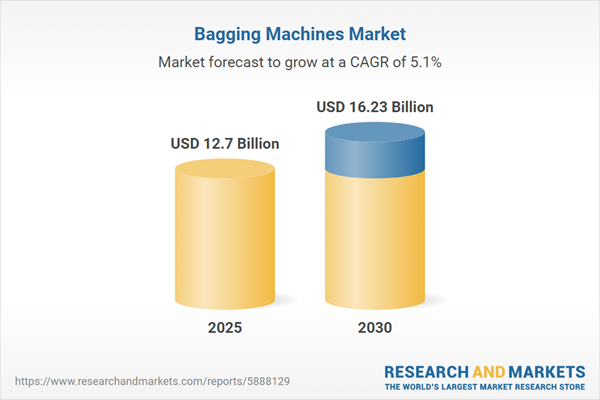Speak directly to the analyst to clarify any post sales queries you may have.
The global bagging machines market is at the center of evolving industrial demands, driven by rising automation, sustainability imperatives, and shifting supply chain strategies. Senior decision-makers seeking insight into technology advancement and regional opportunities will find this report essential for effective planning and resource allocation.
Market Snapshot: Size, Growth, and Trajectory
The Bagging Machines Market grew from USD 12.06 billion in 2024 to USD 12.70 billion in 2025. It is expected to continue growing at a CAGR of 5.20%, reaching USD 18.10 billion by 2032. Market growth stems from heightened demand across food, agriculture, chemical, and pharmaceutical sectors, fueled by innovations that combine throughput, product safety, and environmental stewardship.
Scope & Segmentation: Addressing Diverse Industry Needs
- Machine Types: Horizontal Form Fill Seal, Pillow Bag, Valve Bag, and Vertical Form Fill Seal (Fully Automatic and Semi-Automatic)
- Automation Levels: Fully Automatic (Cam Driven, Servo Driven), Semi-Automatic (Electric, Pneumatic), Manual
- Packaging Materials: Composite, Paper Film (Coated Paper, Kraft Paper), Plastic Film (Polyethylene, Polypropylene)
- End User Industries: Agriculture, Chemical (Detergents, Fertilizers, Petrochemicals), Food (Confectionery, Frozen Foods, Snack Foods), Pharmaceutical
- Bag Sizes: Up To 5 Kg (0 To 1 Kg, 1 To 5 Kg), 5 To 15 Kg, Above 15 Kg (15 To 25 Kg, More Than 25 Kg)
- Regional Coverage: Americas (United States, Canada, Mexico, Brazil, Argentina, Chile, Colombia, Peru), Europe, Middle East & Africa (United Kingdom, Germany, France, Russia, Italy, Spain, Netherlands, Sweden, Poland, Switzerland, United Arab Emirates, Saudi Arabia, Qatar, Turkey, Israel, South Africa, Nigeria, Egypt, Kenya), Asia-Pacific (China, India, Japan, Australia, South Korea, Indonesia, Thailand, Malaysia, Singapore, Taiwan)
- Leading Companies: Syntegon Technology GmbH, MULTIVAC Sepp Haggenmüller SE & Co. KG, GEA Group Aktiengesellschaft, ProMach, Inc., IMA S.p.A., Ishida Co., Ltd., ULMA Packaging, S. Coop., PAC Machinery LLC, Nichrome India Limited, Haver & Boecker OHG
Key Takeaways for Senior Decision-Makers
- The integration of servo-driven actuators and Industrial Internet of Things (IIoT) technologies is transforming operational efficiency and predictive maintenance for bagging machines.
- Growing demand for eco-friendly packaging solutions is driving the adoption of recyclable films and modular machine designs across manufacturing lines.
- Strategic nearshoring and partnership efforts are mitigating supply chain risks, particularly in response to regulatory changes and tariffs.
- Market segmentation is becoming more granular, enabling tailored solutions that align with varying industry requirements, automation preferences, and packaging materials.
- Industry leaders stand out through robust aftermarket support, advanced analytics, and alliances with both material and automation suppliers.
Tariff Impact on Supply Chain and Pricing
The 2025 United States tariff regime has increased costs for components and systems sourced globally, prompting manufacturers to localize production and optimize supplier relationships. In response, industry players are enhancing aftermarket support and offering bundled services such as predictive maintenance and operator training to maintain competitiveness and manage cost pressures.
Methodology & Data Sources
This report’s insights are drawn from primary interviews with engineers, procurement heads, and packaging managers, as well as structured surveys capturing system performance benchmarks. Secondary research includes technical journals and industry white papers, analyzed through triangulation and peer-reviewed frameworks to ensure reliability and depth.
Why This Report Matters
- Enables leaders to benchmark current capabilities and identify areas for technology upgrades or process optimization in bagging machines.
- Supports strategic planning by offering nuanced analysis of trends, regulatory environments, and innovation pipelines.
- Equips organizations to navigate changing market conditions, maximizing uptime and value by leveraging actionable recommendations.
Conclusion
The bagging machines industry is defined by ongoing innovation, regulatory adaptation, and the increasing relevance of sustainability. Stakeholders making timely investments in technology, regional partnerships, and services are well-positioned to capitalize on emerging opportunities and drive operational excellence.
Additional Product Information:
- Purchase of this report includes 1 year online access with quarterly updates.
- This report can be updated on request. Please contact our Customer Experience team using the Ask a Question widget on our website.
Table of Contents
3. Executive Summary
4. Market Overview
7. Cumulative Impact of Artificial Intelligence 2025
Companies Mentioned
The companies profiled in this Bagging Machines market report include:- Syntegon Technology GmbH
- MULTIVAC Sepp Haggenmüller SE & Co. KG
- GEA Group Aktiengesellschaft
- ProMach, Inc.
- IMA S.p.A.
- Ishida Co., Ltd.
- ULMA Packaging, S. Coop.
- PAC Machinery LLC
- Nichrome India Limited
- Haver & Boecker OHG
Table Information
| Report Attribute | Details |
|---|---|
| No. of Pages | 198 |
| Published | October 2025 |
| Forecast Period | 2025 - 2032 |
| Estimated Market Value ( USD | $ 12.7 Billion |
| Forecasted Market Value ( USD | $ 18.1 Billion |
| Compound Annual Growth Rate | 5.2% |
| Regions Covered | Global |
| No. of Companies Mentioned | 11 |









